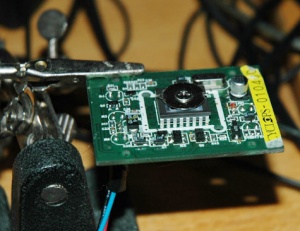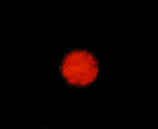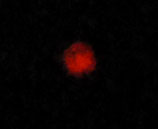Americium 241
Americium 241 emits mainly alpha and gamma radiation. It has a half life of 432.2 years, by emitting alpha particles it turns into neptunium-237.
- Activity
- 3.428 Ci/g
- Average energy of most abundant emission
- Alpha - 5.49 MeV
- Gamma & X-rays - 59.54 keV (Dose rate at 1 m distance (mSv/h*GBq) = 0.085)
| Type | Energy | Percentage |
|---|---|---|
| Alpha | 5.485 MeV | 84.5 % |
| Alpha | 5.443 MeV | 13.0 % |
| Gamma | 59.5 keV | 35.9 % |
| Gamma | 26.3 keV | 2.4 % |
| Gamma | 13.9 keV | 42 % |
Most of the radiation does not travel very far from the sample, the alpha radiation does not pass through more than 3 cm of air and is stopped by almost any solid object. The weaker gamma radiation will pass through some solid objects but at distance of a few metres it is mostly harmless.
At close range the radiation is intense enough to affect electronic devices. Even small samples ionize the air around it, this effect is used in some smoke detectors. The radiation caused a 74HCT14 Schmitt trigger to oscillate at a distance of a couple of centimetres. Most likely this was because the air becoming ionized by the radiation and conducting a weak current from an output pin to an input pin.
Most of the radiation does not travel very far from the sample but at close range it is intense enought to affect electronic devices. Even small samples ionize the air around it, this effect is used in some smoke detectors. The radiation caused a 74HCT14 Schmitt trigger to oscillate at a couple of cm distance. Most likely this was because the air becoming ionized by the radiation and conducting a weak current from an output pin to an input pin.
Radiation detection with a CCD chip
The reccomended method for detection of radiation from Am-241 is a ZnS scintillation counter but a bare CCD chip works quite well for detecting some types of radiation.
This video shows how the radiation affects a CCD imaging chip covered with a glass plate. Since the glass will stop all the alpha radiation only the gamma and beta radiation hits the CCD surface. Hot pixels show up at random moments. This would be suitable as a base for generating true random numbers.
Fluorescence of phosphor
The radiation is capable of exiting phosphors found inside low energy light bulbs. The phosohor light up very dimly with a red colour. It is almost impossible to see with the naked eye. The eye is not capable of determining the colour but a long exposure photograph shows the colour well.
The material that is exited by the radiation is most likely europium-doped yttrium trioxide (Y2O3:Eu) with an emission band at 612 nm. Since the brightness is reduced by over 90% by the 0.015 mm aluminium foil it must be alpha radiation that exites the phosphor since gamma radiation will pass through the foil quite easily.


